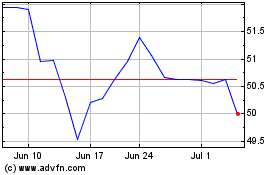By Saabira Chaudhuri
This article is being republished as part of our daily
reproduction of WSJ.com articles that also appeared in the U.S.
print edition of The Wall Street Journal (April 4, 2019).
Falling alcohol consumption is often attributed to
health-conscious millennials. But some of the fastest-growing
alcoholic drinks in America are "alcopops," or strong, sugary
alcoholic sodas, aimed at younger drinkers.
To tap the trend, Guinness maker Diageo PLC last year launched
Smirnoff Ice Smash, a fruit-flavored, 8% alcohol-by-volume version
of its longstanding lower-alcohol Smirnoff Ice alcopop. Sales of
Smash have grown 400% over the past six months, according to the
company. The canned drink is Diageo's most successful product
launch in U.S. convenience stores, despite the shift toward
healthier drinks.
"We debate this ourselves on a daily basis," said Nuno Teles,
Diageo's head of U.S. beer, reflecting on the popularity of Smash
beverages at a time when Americans are increasingly reaching for
healthy options. "We see two different consumers."
Miller Lite owner Molson Coors Brewing Co. in January launched a
sixth flavor of its 8% alcohol-content Steel Reserve Alloy alcopop
called "Spiked Tropic Storm" after taste tests showed it appealed
to 21-to-27-year-old consumers. It said that sales of the brand are
up 11% so far this year and that its data indicates millennials of
both genders are driving Steel Reserve Alloy sales growth. The
brewer also sells 24-ounce cans of its Redd's Wicked alcopop at gas
stations, pharmacies and delis. A new seasonal flavor, sour apple,
sold so well that the company recently turned it into a full-time
offering.
Sales of alcopops with 6% or higher alcohol content grew 4.7% to
$1.14 billion last year in grocery, convenience and liquor stores,
according to research firm Nielsen. That compares with a decline of
3.6% for similar alcopops under 6% ABV and a 0.2% drop in beer
sales. Wine sales climbed 2.1% and spirits 3.1%.
The alcopop figures include traditional flavored malt beverages
like Smirnoff Ice, as well as hard sodas, teas and coffees, but
exclude spiked seltzers. Alcopops generally contain less booze than
wine and spirits, but have levels comparable to or higher than most
beers. While exact numbers aren't available, industry executives
and analysts say that millennial-age drinkers are among the largest
buyers of alcopops.
"Health and wellness is not a trend for all consumers," said
Anheuser-Busch InBev SA Chief Executive Carlos Brito in an
interview. "For some, when they go to some occasions, they want
higher [alcohol] products, they don't care about the calories."
The Budweiser brewer in January rolled out Ritas Spritz, a
series of canned, sparkling margarita and sangria drinks containing
6% alcohol in flavors like cherry lime and strawberry blueberry. It
also sells a higher-alcohol line of flavored Ritas alcopops in
regular and large cans.
Made from a base of malt that is flavored to resemble a premixed
cocktail, alcopops are attracting drinkers seeking strong flavors.
Widely found in 7-Eleven and similar chains, they offer a
relatively cheap and convenient option for drinkers seeking a buzz.
The drinks are generally taxed like beer -- less than spirits or
wine -- despite often being stronger and containing spirits.
Alcopops, which exploded in popularity in the 1990s, have grown
at 2.5% a year from 1990 to 2018 in the U.S., according to industry
tracker IWSR. It says the category has doubled in size over that
time, from 45 million nine-liter cases to over 90 million
nine-liter cases.
These sugary, flavored drinks have drawn fire for targeting
young people, who are often attracted by their resemblance to soft
drinks. Companies say they seek to appeal to legal-age drinkers,
although they acknowledge the demographic for these ready-to-drink
beverages skews young.
Smirnoff Ice Smash reminds Mary Cochran of a pink Popsicle.
"It's pretty decent," said the 26-year-old from Charlotte, N.C.,
who posts video reviews of drinks in her free time. "But I still
feel like it's just so full of sugar that it can't be a good
decision."
AB InBev's Natty Rush brand is aimed at young drinkers who don't
have lots of disposable income and haven't taken to beer, says
Chelsea Phillips, vice president of marketing for AB InBev's
"Beyond Beer" unit. The drink, which has an alcohol content of 8%,
is sold in flavors including "Watermelon Smash" and "Hurricane
Punch."
The growing popularity of alcopops is a boon for brewers, who
typically include the drinks in their beer-volume figures, helping
offset slowing demand for some of their biggest lager brands and
lure back consumers defecting to wine and spirits.
Executives say sugary alcopops aren't being hurt by the
popularity of so-called spiked seltzers. This smaller, newer
category of drinks, which includes brands like White Claw and
Smirnoff Seltzer, is aimed at more health-conscious consumers.
Sales of spiked seltzers -- which typically contain less alcohol
than traditional alcopops -- are sugar-free and have fewer
calories, soared 169% last year to $488 million, according to
Nielsen.
High-calorie alcopops and spiked seltzers are often drunk by the
same consumers, just on different occasions, said Ms. Phillips. She
reflected on this seeming inconsistency in her own life, saying she
eats a lot more salad now but still keeps cookie dough in the
fridge for when she wants to indulge.
Write to Saabira Chaudhuri at saabira.chaudhuri@wsj.com
(END) Dow Jones Newswires
April 04, 2019 02:47 ET (06:47 GMT)
Copyright (c) 2019 Dow Jones & Company, Inc.
Molson Coors Beverage (NYSE:TAP)
Historical Stock Chart
From Mar 2024 to Apr 2024

Molson Coors Beverage (NYSE:TAP)
Historical Stock Chart
From Apr 2023 to Apr 2024
